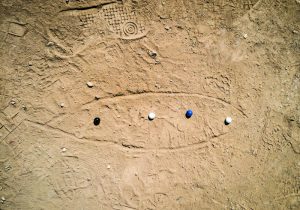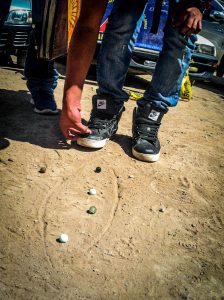Marbles Snap in Cuzco’s Dust

A game with marbles, called los tiros (the toss) or canicas, is one of the most well known games of youth. It, along with tops, occupies the pinnacle of childhood attention, or at least it did before video games began to take over. Young people play the game, but so too do adults. They come together to play and in this way share emotions, laughter, and happiness.
To play this game you must first learn to take a shot, what we call “tincar el tiro”. You hold the marble with your fingernail and a finger which puts pressure on the marble so that it shoots out at great velocity and snap into an opponent’s marble. People snap the marbles off their sneakers. Of course there are different ways of taking a shot and each person develops their own.

With marbles you can play different games, such as shots, the game called charas, and the one of matas (or you kill).
To play tiros you need at least two players and they need more than two marbles so that they can play various rounds. You first seek a place that is flat and has dirt. In it you draw the olla and the kuti (the pot and the return).
There are two types of ollas. The most common is in the shape of a fish while the other is simply round. That is where more people play and they make more shots.

The kuti is a line that is drawn a certain distance from the olla. The person who gets closest to it with his shot is he who takes the first shot of the game. He also gets to decide how the game is going to go.
There are two options: napana and topato. Napana is a rule in which you play cleanly with no tricks while topata allows for various tricks.

According to some people to play with the topata rules makes for a coward’s game. Others say that it is a style that requires all kinds of smarts (viveza) and intelligence. There are various things with this set of rules, such as “basta la caida (the fall is enough). Any of the players can demand this rule when he needs to “kill”, take out, the player who has all of his marbles in the olla. At that point they play in the olla. The person involking the rule places his marble on a rock. To be able to kill the opposing players marble he just has to move the rock and let his marble fall on his opponent’s. The player then leaves the game with all the marbles he has been able to win in the pot.
“Te alcanzo con la mano derecha en tres” (I reach you in three with my right hand) ias another of the tricks that falls under topata. It happens when a player grabs or touches his marble when it is not his turn. Once called the opponent speaks and has the opportunity to win more quickly because he has three turns in a row. For them he can get close. He shoots very close to his opponent.
He kills him and then wins the game by obtaining all the marbles that are bet in the olla.
“Te quemas en Kuti” (you burn on the return) is a rule that applies when one of the players got almost all the marbles from the olla and there only remains one to play. All of the opponents should kill it so that all the marbles are not taken. When this rule comes into force, the player cannot shoot past the line of the kuti. If his marble goes beyond the line, he immediately places the marbles he won in the olla and loses the game.
The game of charas is completely different from the game of tiros, or shots. In this game you have to hit two marbles so that you can win. For this game there is no olla, just a kuti.
To play matas (you kill) you need two or more people who can only compete with just one marble. For this there is no kuti nor olla. You only win if you are able to kill (hit) the opponent’s marble from any distance.
Everyone who plays these games has lots of fun. They fill with adrenaline and only winning matters, no matter how they accomplish it. The others lose their marbles. They leave the field of play with tears in their eyes. The next day they are out there again with other strategies and hopes that today they will be the winner.




